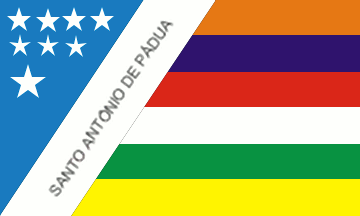 image located by Dirk Schönberger,
31 October 2011
image located by Dirk Schönberger,
31 October 2011Source: http://www.santoantoniodepadua.rj.gov.br/brasao.php

Last modified: 2012-04-07 by ian macdonald
Keywords: rio de janeiro | santo antônio de pádua |
Links: FOTW homepage |
search |
disclaimer and copyright |
write us |
mirrors
 image located by Dirk Schönberger,
31 October 2011
image located by Dirk Schönberger,
31 October 2011
Source:
http://www.santoantoniodepadua.rj.gov.br/brasao.php
Most of the flag is composed of six equal horizontal stripes, orange, dark blue, red, white, green, yellow; over the hoist, a lighter blue triangle extending from the lower hoist corner to about one-third of the length along the top, bearing a row of four white stars above a row of three slightly smaller white stars, above one larger white star; the boundary of the blue triangle and the six horizontal stripes a broad white band, with the name written in an ascending diagonal.
Official website at
http://www.santoantoniodepadua.rj.gov.br
Dirk Schönberger, 31 October 2011
The municipality of Santo Antônio de Pádua (40,589 inhabitants in 2010; 612 sq. km) is located in northwestern Rio de Janeiro State, on the border with Minas Gerais, 260 km of Rio de Janeiro. The municipality is made of the town of Santo Antônio de Pádua proper and of the districts of Baltasar, Santa Cruz, Campelo, Marangatu, Monte Alegre, Paraoquena, São Pedro de Alcantara and Ibitiguaçu. Santo Antônio de Pádua was founded on 26 July 1833 by Friars Florido de Cittą di Castelli and Bento Giovanni Benedetta Libilla, aka Bento de Gênova, on pieces of land offered by João Francisco Pinheiro and João Luiz Marinho. Pinheiro asked the place to be named Arraial da Cachoeira and to be dedicated to his patron saint, St. Felix; the place was subsequently known as Arraial de São Félix. A chapel dedicate to St. Anthony of Padua was built in 1841, so that the village was renamed Arrial de Santo Antônio de Pádua. The commune of Santo Antônio de Pádua was established by Provincial Law No. 296 of 1 June 1843 and made a "cidade" by State Decree No. 2,597 of 2 January 1882.
The flag of Santo Antônio de Pádua, designed by Ruy Macedo de Azevedo, is prescribed by Resolution No. 469 of 3 November 1964, confirmed on 11 November 1964. The flag was officially inaugurated on 12 June 1965. The design and the colors follow the rules of heraldry. The colors recall the origin of the inhabitants: Portugal, Italy, Syria and Lebanon, Spain and Africa. The stars represent the nine districts forming the municipality. The bigger star must represent the seat of the municipality, the town of Santo Antônio de Pádua proper.
The coat of arms of Santo Antônio de Pádua, sketched by Maria Paula de
Souza Azevedo and fitted to the heraldic norms by Gilberto Antônio
Pereira on 3 November 1969, was adopted after a public contest
prescribed by Resolution No. 455 of 16 September 1964. Like the flag,
it includes a quarter azure with nine stars argent and a bend sinister
argent inscribed with the name of the municipality in letters sable.
http://www.santoantoniodepadua.rj.gov.br/brasao.php
Ivan Sache, 18 March 2012